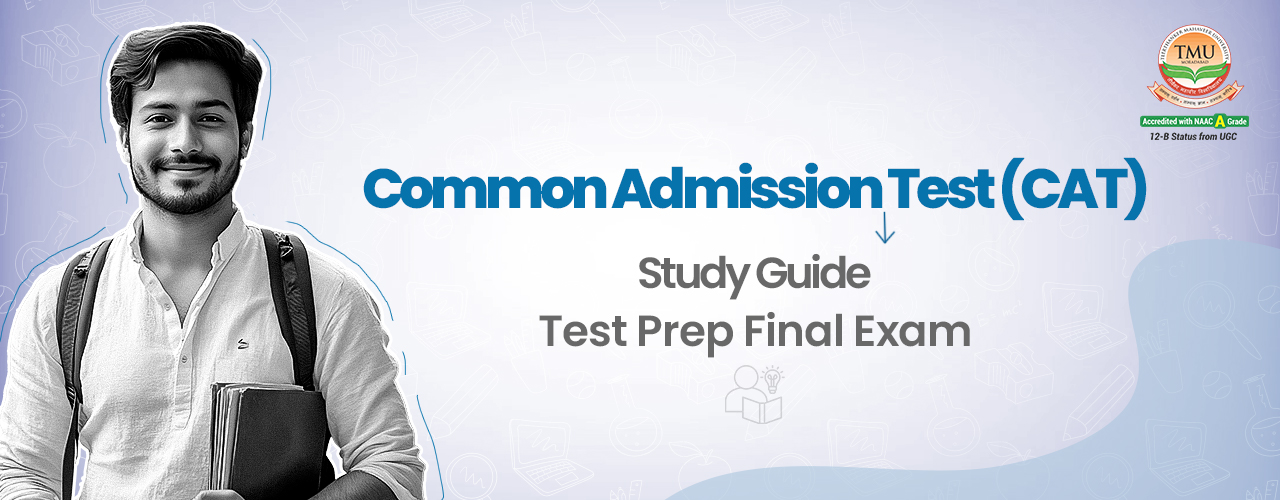Common Admission Test (CAT): Study Guide & Test Prep. of Final Exam
Table of Contents
Common Admission Test (CAT) is one of the most competitive exams in India, primarily used for admission into the prestigious Indian Institutes of Management (IIMs) and other top business schools. With thousands of aspirants vying for limited seats, CAT is not just a test of knowledge but also of strategy and time management.
This article is your complete study guide and test prep for the final CAT exam, ensuring that you're fully prepared to tackle this challenge head-on.
Understanding the CAT Exam Format
Sections of the CAT Exam
The CAT exam is divided into three primary sections:
- Verbal Ability and Reading Comprehension (VARC): Tests language proficiency, comprehension, and reasoning skills.
- Data Interpretation and Logical Reasoning (DILR): Focuses on analytical skills, interpreting data, and logical problem-solving.
- Quantitative Aptitude (QA): This section tests mathematical ability and numerical problem-solving.
Duration and Marking Scheme
The total duration of the Common Admission Test (CAT) exam is 120 minutes, with each section having a time limit of 40 minutes. The marking scheme includes +3 marks for every correct answer and -1 for every incorrect answer. Questions may either be Multiple Choice Questions (MCQs) or non-MCQ types.
Teerthanker Mahaveer University
Apply for Admission
Click Here To Apply for Admission
CAT 2024 Key Dates and Deadlines
It’s crucial to stay updated with CAT 2024 important dates. Missing any deadline can hinder your preparation.
| Event | Dates |
| Registration Start | August 1, 2024 |
| Registration End | September 13, 2024 |
| Admit Card Release | November 5, 2024 |
| CAT 2024 Exam Date | November 24, 2024 |
| Result Announcement | January 2025 (Tentative) |
Registration Process
The registration process for CAT is entirely online. You need to visit the website (https://iimcat.ac.in/) and create an account, fill in your details, upload the necessary documents, and pay the fee to complete your application.
Eligibility Criteria for CAT
Academic Qualifications
To be eligible for CAT, candidates must have a bachelor's degree with at least 50% marks (45% for SC/ST/PwD candidates) or an equivalent GPA from a recognised university.
Age and Attempt Limitations
There is no age limit or restriction on the number of attempts for the CAT exam, making it accessible to a wide range of aspirants.
Syllabus for CAT 2024
The syllabus for the Common Admission Test (CAT) 2024 is divided into three major sections: Verbal Ability & Reading Comprehension (VARC), Data Interpretation & Logical Reasoning (DILR), and Quantitative Aptitude (QA). Here's a detailed breakdown:
| Section | Topics Covered |
| Verbal Ability & Reading Comprehension (VARC) | Reading Comprehension (RC): Passages followed by questionsVerbal Ability: Grammar, Sentence Correction, Vocabulary, Para jumbles, Sentence Completion, Synonyms, Antonyms, etc. |
| Data Interpretation & Logical Reasoning (DILR) | Data Interpretation (DI): Bar Graphs, Pie Charts, Line Graphs, Tables, Caselets, Data SufficiencyLogical Reasoning (LR): Seating Arrangements, Blood Relations, Syllogisms, Venn Diagrams, Puzzles, etc. |
| Quantitative Aptitude (QA) | Arithmetic: Percentages, Profit & Loss, Simple and Compound Interest, Time & Work, Ratios & ProportionsAlgebra: Quadratic & Linear Equations, InequalitiesGeometry & Mensuration: Circles, Triangles, Polygons, Coordinate GeometryNumber Systems: Divisibility, LCM, HCF, FactorsModern Math: Permutations & Combinations, Probability, Sequences & Series, Logarithms, etc. |
Preparation Strategies for CAT
Understanding the Exam Pattern
Knowing the exam structure helps you plan better. Ensure you are familiar with time constraints and the type of questions you’ll face.
Time Management Tips
Since each section has a fixed time limit, it’s important to practice managing your time effectively. Focus on speed and accuracy.
Section-wise Preparation Tips
Verbal Ability and Reading Comprehension (VARC)
- Improve your reading speed by reading articles, newspapers, and books.
- Practice para jumbles and comprehension passages regularly.
Data Interpretation and Logical Reasoning (DILR)
- Solve a variety of puzzles and practice interpreting complex data.
- Focus on speed, as DILR is known for its time-consuming questions.
Quantitative Aptitude (QA)
- Practice fundamental topics like algebra, geometry, and arithmetic.
- Learn shortcuts for solving math problems quickly.
Books and Resources for CAT Preparation
Here’s a list of some books and resources to aid your CAT prep:
- Quantitative Aptitude for CAT by Arun Sharma
- Verbal Ability and Reading Comprehension for CAT by Nishit Sinha
- Data Interpretation & Logical Reasoning by Gautam Puri
You may purchase books of your choice. The above-mentioned books are not mandatory to purchase.
How to Create an Effective Study Plan for CAT
Setting Realistic Goals
Don’t overwhelm yourself with unrealistic expectations. Divide your preparation into smaller, achievable milestones.
Dividing Time Between Sections
Focus on balancing your preparation between all sections, but allocate extra time to areas you find more challenging.
Common Mistakes to Avoid During CAT Preparation
Overemphasising One Section
A common mistake is to focus too much on one section at the expense of others. Balance your prep across all sections.
Ignoring Mock Tests
Mock tests help you gauge your preparation level. Don’t ignore them.
Importance of Mock Tests and Previous Year Papers
How Mock Tests Help Improve Speed and Accuracy
Taking regular mock tests helps build exam-day stamina and allows you to improve both speed and accuracy.
Analysing Previous Year’s Papers
Study previous years’ papers to understand the pattern of questions and difficulty levels.
How to Stay Motivated During CAT Preparation
Staying Consistent
Stay on track by following a well-structured schedule and avoiding long breaks.
Handling Stress and Burnout
Remember to take breaks, meditate, or engage in hobbies to avoid burnout during preparation.
Last-Minute Preparation Tips
Revise Formulas and Key Concepts
Spend the last few days revising important formulas and concepts instead of starting new topics.
Don’t Start Anything New
It’s crucial to stick to what you’ve already studied rather than attempting new material in the final week.
What to Do on the CAT Exam Day
Reaching the Exam Centre on Time
Ensure you arrive at the exam centre well ahead of time to avoid any last-minute rush.
How to Manage Time During the Exam
Break down the exam into smaller time segments for each section, ensuring you attempt all questions.
Conclusion
Cracking the CAT exam requires consistent effort, a well-planned strategy, and the right mindset. By following the steps outlined in this guide, you can maximize your chances of acing CAT 2024. Remember, practice and perseverance are key to success.
FAQs
Q: What is the minimum percentage required for CAT eligibility?
Ans: You need at least 50% marks in graduation (45% for SC/ST/PwD candidates).
Q: How many sections are there in the CAT exam?
Ans: CAT has three sections: VARC, DILR, and QA.
Q: Can I take CAT without coaching?
Ans: Yes, many candidates clear the CAT through self-study and online resources.
Q: How often can I attempt the CAT exam?
Ans: There is no limit on the number of attempts for CAT.
Q: What are the top books for CAT preparation?
Ans: Some popular books include Arun Sharma’s & RS Agrawal’s Quantitative Aptitude and Nishit Sinha’s Verbal Ability.















